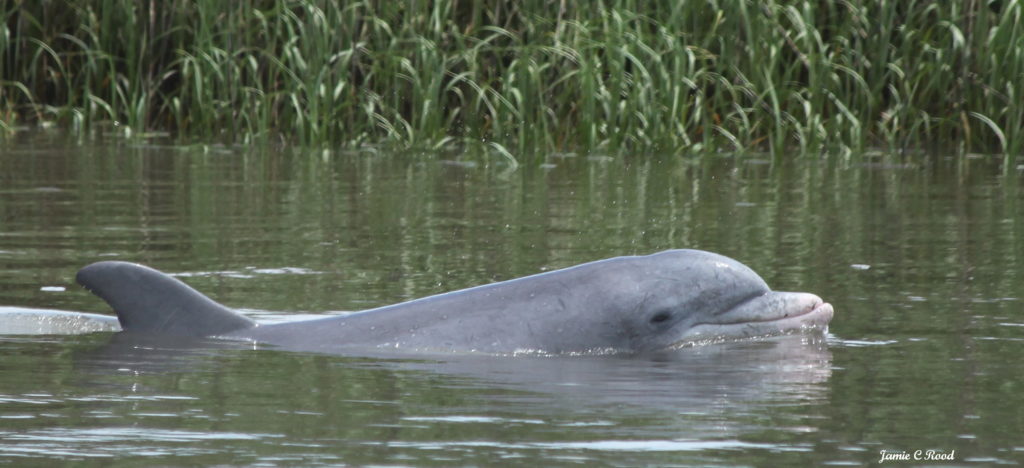post
Dolphin Watching at Kiawah Island

Meandering slowly down the winding river in a kayak, the banks redolent with the pungent aroma of plough mud, is the best way to experience dolphin watching on Kiawah Island. Launched from the boat dock at Kiawah Island Golf Resort’s Mingo Point, guests can put kayaks directly into the Kiawah River. Taking a guided excursion with a Resort naturalist is the ideal route. The Resort’s trained naturalists have spent a lot of time on the river and have thoroughly learned its incredible biodiversity and can unravel many of its mysteries. Top among those, though, is the river’s population of bottle-nosed dolphins—full-time residents in this brackish paradise.
We feel a special affinity for dolphins, a kinship derived from our shared status as mammals. Dolphin intelligence and curiosity, even their complex communication system and ability to learn new skills to adapt to their environment—and the fact they they are highly social—strengthens our perceived bond with them. The Resort not only permits guests to observe these resident dolphins in their native habitat, it encourages it. Close encounters can lead to greater appreciation and understanding.
To have an ideal dolphin encounter at Kiawah, it helps to have an understanding of the “rules of the road” beforehand. Fortunately, we have a local resource that can provide expert advice based on solid scientific research about responsibly encountering dolphins. Marine biologist Lauren Rust, founder and executive director of Lowcountry Marine Mammal Network (LMMN), offers two simple rules to be a good houseguests when visiting the island’s dolphins.
Keep Your Distance
First rule of thumb: dolphins should be observed, but never approached. From a kayak, never paddle closer than 50 yards towards a dolphin when you spot it. “Dolphins are naturally curious, and they are accustomed to kayaks, so they often will approach them,” says Rust. That’s fine, she says, but just sit still and let them dictate the terms. “If a dolphin starts approaching you, do not close the distance to ‘meet it halfway,’ rather let the dolphin set the terms.”
One of the most incredible natural phenomena observed on Kiawah Island is our pod of river dolphins strand feeding, a rare learned behavior passed down through generations that has only been observed in several locales on earth. The dolphins swim in a line, herd baitfish onto the bank, then intentionally beach themselves momentarily to feast on the prey. It is incredibly tempting when you see it occurring to want to get a closer look, but if you paddle closer, it will actually disrupt the activity. The long-term effect can be even more devastating: dolphins have numerous ways of securing fish, so if strand feeding gets disrupted too many times, there is a high risk Kiawah’s dolphins will just abandon the behavior, and this rare phenomenon would be lost forever.
Don’t Feed the Dolphins
Humans are naturally nurturing creatures. That urge can become detrimental if we succumb to it by feeding dolphins. Dolphins have very particular dietary needs that human foods cannot satisfy. The problem is, while we think that a little “human treat” here and there can’t hurt, dolphins are incredibly fast learners. It can take as little as two times being fed from a watercraft for a dolphin to permanently alter its natural behavior. “They will quickly come to associate the presence of humans with food,” explains Rust.
From there, it is a slippery slope. A fed dolphin will begin approaching a kayaker more frequently and much closer—sometimes more aggressively, which could have frightening results. A fed nursing mother is even more threatened by being fed. She will neglect her young to pursue watercraft. She will also fish less, meaning she is not getting the high caloric intake needed to produce the milk her calf desperately depends on. (“A box of cereal is not an adequate food for a dolphin,” Rust says.) Continuing down the slippery slope, dolphins that pursue human food also have a much higher rate of reproductive failure, meaning fewer calves are born. From there, it does not take long for a population of dolphins to be seriously jeopardized.
The good news is, Kiawah River’s resident dolphin population has remained steady over at least the last two decades, and appears to be quite healthy, especially compared to other resident river dolphin populations in neighboring states. So, armed with the rules, book an excursion with a Kiawah Island Golf Resort naturalist, hit the river and get a close (but not too close) encounter with these amazing wild creatures.